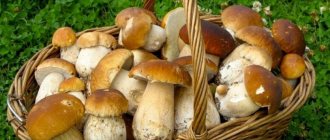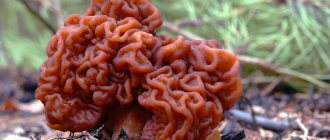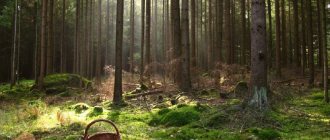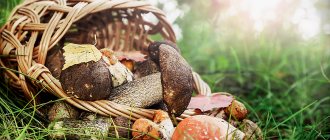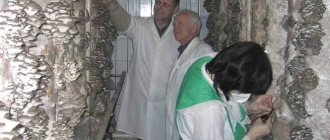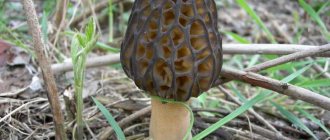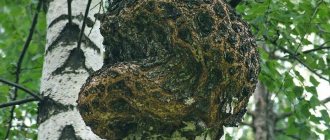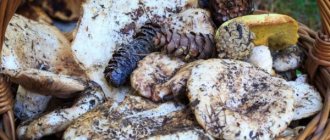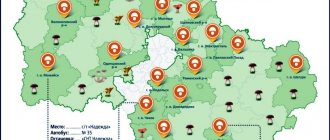We list edible and inedible mushrooms that, in warm weather, can be found in the forest in late spring - early summer.
Traditionally, mushrooms appear around mid-summer, when the ground is already sufficiently warm and moist. But sometimes, at the end of spring, the weather throws up surprises - and you can start collecting forest gifts much earlier. And since this year spring pleased us with warm weather and rains, lovers of “quiet hunting” have already managed to boast of their first mushroom “trophies”. How not to make mistakes when picking mushrooms, and what should you know about it?
Edible mushrooms in May-June
Many people know that edible mushrooms include the so-called “conditionally edible”. Such mushrooms must be boiled, and sometimes even pre-soaked before cooking. Most conditionally edible mushrooms appear in forests and fields in the second half of summer.
Russula blue-yellow
Photo from wikipedia.org
Russula is perhaps the most famous and harmless mushroom, which, however, also has inedible “relatives”. Under good weather conditions, edible blue-yellow russula may appear as early as early summer. It has a hemispherical cap with a diameter of 5 to 15 cm, which over time becomes convexly prostrate, and a stalk 5-12 cm long and 1.5-3 cm thick, which subsequently becomes hollow. The mushroom has frequent wide plates of white or creamy white color and white flesh.
Oyster mushroom
Photo from mushroomobserver.org, author - Iv Merlu (Merlu)
The mushroom is lamellar, has a fleshy cap with a diameter of 5 to 15 cm (sometimes can reach 30 cm), which changes its color from dark gray to ashy with a purple tint, then fades to whitish, grayish or yellowish. The leg is short, narrowed towards the base, and becomes very rigid over time. Also, with the age of the mushroom, the pulp also changes - from white and dense to hard and fibrous. The corniculate oyster mushroom can be found in the forest as early as May-June.
Steppe oyster mushroom, photo from wikipedia.org, author - Apple2000
Starting from May, in pastures in the southern regions of Russia you can also find steppe oyster mushroom - an edible agaric mushroom with a pinkish-cream cap 4.5-13 cm in diameter, with a stem 2 to 5 cm high and up to 2.5 cm thick. The mushroom loves to settle next to umbrella plants.
Oyster mushroom
Photo from wikipedia.org, author - Jörg Hempel
A lamellar mushroom with a pubescent white stalk up to 1.5 cm in height, with a tongue-shaped or convex-spread cap with a diameter of 4-9 cm and thin white flesh. Appears in forests already in May, prefers rotting wood.
Oyster mushroom or oyster mushroom
Photo from wikipedia.org, author - Aaron Sherman
The most popular of all mushrooms of the Oysteraceae family. It has a fleshy cap from 5 to 30 cm in diameter and plates from 3 to 15 mm in width, as well as a short dense stalk from 2 to 5 cm in length. Most often it grows in groups on trunks or stumps of deciduous trees, less often on coniferous trees. Under favorable weather conditions it may appear as early as June.
Oyster mushroom is the second most popular cultivated mushroom in Russia (we are, of course, talking about edible species). The first place in terms of cultivation volumes in the country, as well as throughout the world, is occupied by champignon.
Semi-white mushroom
Photo from wikipedia.org, author - George Chernilevsky
Belongs to the Boletaceae family. Received the popular name - yellow boletus. The mushroom is tubular and edible, despite the fact that when raw it smells like gouache, but after cooking this smell disappears. It has a cap with a diameter of 5 to 20 cm, initially convex, then flatter, with dense flesh. The stem of the mushroom is dense, thickened at the bottom, up to 10 cm in height on average. It grows in deciduous or mixed forests starting from the end of June, but mushroom pickers who know the place find it in warm weather already in May.
Porcini
Photo from wikipedia.org, author - Strobilomyces
Popularly called boletus. A tubular mushroom has a convex cap with a diameter of 7-30 cm. The color of its skin varies from red-brown to almost white, darkening with age. The stem of the mushroom is massive, from 7 to 25 cm in height, the flesh is strong. Like the semi-white mushroom, in warm weather it begins to grow in May.
Common boletus
Photo from wikipedia.org, author - alexntor
A tubular mushroom with a cap of various colors - from white to dark gray, up to 16 cm in diameter, convex or cushion-shaped, with white flesh. The leg is elongated, white or grayish-speckled in color. Due to its name, it prefers to settle in birch forests, but is also found in mixed ones, and also likes to grow in swampy areas and in moss. Traditionally, it can be found in the indicated places already in late May - early June.
Red boletus
Due to the color of its cap, this tubular mushroom received the colloquial name “redhead.” It has a cap from 4 to 20 cm in diameter, initially hemispherical with the edge tightly pressed to the stem, then convex in shape, and a stem up to 15 cm high with a grayish-white surface covered with brownish longitudinal-fibrous scales. It especially likes to settle under young aspens, which is why it got its name; however, it is also seen in mixed forests. You can meet it in its favorite habitats starting from the first ten days of June.
Common champignon, or pecheritsa
It is distinguished by a hemispherical cap 8-15 cm in diameter and white flesh that turns red at the break. The mushroom plates turn pink over time. The leg can reach 9 cm in height and has a wide white ring approximately in the middle. It loves soil rich in humus - for this reason it can be found in gardens faster than in the forest, starting in May.
Spiky raincoat
Attention! The mushroom is edible only when young, and when its flesh turns yellow, it cannot be eaten. This raincoat is club-shaped and covered with a shell with small spikes on top, for which its name was supplemented with an appropriate adjective. This mushroom can be found both in forests and meadows from June. It also has a meadow analogue, which does not have thorns, but has a “fluffy shell”.
Meadow raincoat
Real morel
It is also called the edible morel, although in the Morel family there are also such edible mushrooms as the conical morel (light brown or brown cap), the tall morel (black-brown cap) and the semi-free morel (dark brown cap). Apart from the color of the caps, edible morels are practically no different from each other. The cap is egg-shaped and wrinkled - hence the name of the mushroom. The stem is significantly smaller in size than the cap, white, up to 7 cm in height. In some regions, the mushroom can begin to be collected as early as April.
Summer honey fungus
Photo from wikipedia.org, author - Raphaël Blo
The mushroom cap is from 3 to 6 cm in diameter, at first it is convex, later flat. In dry weather, the mushroom is honey-yellow, however, after rain it turns brownish, with a translucent cap. Its pulp is thin and watery. The leg grows up to 7 cm, with a brown membranous ring, dark brown below the ring. Prefers to settle in groups on stumps in forests of various types. It is called summer, but in abnormally warm weather it can appear as early as May.
Distribution area
June mushrooms grow almost everywhere, but the wave of fruiting is very short in time:
- Cherry blossoms are found in different forest zones, in open forests and among grass, but they give preference to acidic soils and form mycorrhizae with pink-flowered plants;
- a significant part of the talker varieties are difficult to distinguish and are most often collected in forest belts only by experienced mushroom pickers;
- Depending on the variety, summer boletus can be found under young coniferous trees, in mixed pine-birch and pine-oak plantings on well-drained sandy soils. Often found in clearings, forest edges, along roads, as well as under coniferous litter;
- boletus forms mycorrhizae with birches, and grows in mixed forests and birch groves from the first half of summer until late autumn;
- redheads are characterized by a lack of preference for a mycorrhizal partner, so they can grow under many deciduous trees, including aspen and poplar;
- Chanterelles are found almost everywhere in our country, and grow in forests with a temperate climate, forming groups of fruiting bodies;
- summer honey mushrooms grow in numerous colonies on decaying wood or on damaged living deciduous trees.
It should be noted that the lifespan of the fruiting body of summer honey mushrooms, chanterelles and boletus does not exceed ten days. The fruiting bodies of porcini mushroom and boletus retain their nutritional and commercial qualities for about two weeks. The most durable can be considered the fruiting body of the champignon, which can be preserved in natural growing conditions for more than a month.
Inedible mushrooms in May-June
In addition to edible ones, in late spring and early summer you can also find mushrooms in the forest that are not yet classified as poisonous, but for some reason are still inedible.
Russula gall
Photo from wikipedia.org, author - Jerzy Opioła
The mushroom is inedible because it has a pungent taste. Lamellar, distinguished by a cap with a diameter of 4-9 cm, first convex, then flat, as well as a light ocher fusiform or club-shaped leg and white pulp with a geranium scent.
Russula
Our great-grandmothers were sure that russulas with a red or purple cap (acrid russula, blood-red russula, birch russula, sardonyx russula) were “relatives” of the fly agaric, and never ate them. Russulas with a red cap are actually called inedible in some sources due to their unpleasant, burning taste. It is worth noting that the last two of the listed russulas can be found in the forest as early as June.
Oyster mushroom covered
Photo from mushroomobserver.org, author - Gerhard Koller (Gerhard)
This representative of the Oyster mushroom family is difficult to confuse with any other mushroom, but it is also not worth collecting: it is unsuitable for food due to its dense rubbery pulp. Brown-gray, lamellar, with a sessile cap from 3 to 8 cm in diameter with a downward curved edge. The pulp smells like raw potatoes. Mushrooms grow in groups mainly on aspens from May to mid-summer.
Chanterelles
At the end of the month, everyone's favorite chanterelles appear, which are very convenient to collect - they always grow in groups. Chanterelles are one of the most favorite mushrooms of hunters, as they stand out on the green grass with their bright colors. It is difficult to confuse them with other mushrooms, but it is worth remembering that the chanterelle has one unpleasant brother - the false chanterelle. The double has smooth cap edges and a red tint.
“Alas, after the first June wave, mushrooms usually take a break for almost a month, during hot July, and the second wave begins only in August. True, there are exceptions: if it suddenly gets colder, then in July you can find a lot of mushrooms. But here, from the edges dried by the hot sun, you have to go into the depths of the forest, and especially into the spruce forests. White ones must be looked for there, among the needles. If it suddenly gets colder, then in a couple of weeks in July you can find autumn honey mushrooms; now they often confuse the season due to strange weather,” Tikhomirov explained.
Poisonous mushrooms in May-June
Such mushrooms should never be eaten in any form!
Ordinary stitch
Photo from wikipedia.org
A poisonous mushroom, despite the fact that some sources classify it as conditionally edible. The cap is visually similar to the human brain, 10 cm high and 15 cm wide, becoming wrinkled over time. The stem is up to 3 cm long, the flesh is brittle, with a fruity smell. The fungus is marsupial and lives on sandy soils, mostly under coniferous trees. The first lines appear already in April.
In a number of countries, string is officially recognized as a poisonous mushroom, since it contains strong toxins that gradually destroy red blood cells, as well as the central nervous system, liver and gastrointestinal tract.
Spring fly agaric, or spring toadstool
Photo from wikiwand.com
A deadly poisonous agaric mushroom of white color with a hemispherical and subsequently convex cap from 3.5 to 10 cm in diameter, and a stalk up to 12 cm in height. A wide white ring covered with vaguely defined stripes is clearly visible on the stem. The mushroom lives in different forests, starting in spring.
Thin pig
Photo from wikipedia.org, author - H. Krisp
It is classified as poisonous because the toxins it contains can immediately or gradually disrupt the functions of some internal organs and lead to death. The mushroom is distinguished by an olive-brown and later rusty-brown cap, 12-12 cm in diameter with a curled edge, as well as a low stalk. It grows not only in forests, but also in meadows, gardens and in the grass next to high-rise buildings. You can see it as early as June.
It is possible that we have not listed all the mushrooms that could already be observed and collected this season. If you've seen any that we haven't mentioned, please leave a comment. And if you have the opportunity, attach their photo to the comment!
Proper processing
You cannot pick mushrooms near roads, chemical and industrial enterprises, private houses, and farms.
The mycelium (the underground vegetative body of mushrooms) actively feeds on what gets into the soil. Even edible species grown in a polluted environment cannot be used as food. You should also not collect mushrooms whose species are unknown to the mushroom picker.
At the first signs of poisoning, they call an ambulance and, while they are waiting, they begin to carry out urgent detoxification of the body, using available means. In this case, you need to try to preserve the remains of the mushroom dish that caused the problem. This is extremely important because... will greatly facilitate the determination of the type of fungi and, accordingly, the type of toxin that caused poisoning for medical laboratory specialists.
Rules for processing wild mushrooms:
- Sort them by size and type, remove dirt and forest debris from them.
- Cut off rotten or too soft parts, suspicious areas. In some species, the skin is removed from the cap and the stem is removed.
- Rinse wild mushrooms under running water several times. Collect the washed ones and boil in boiling salted water for 5-7 minutes.
- Drain the broth, rinse the mushrooms again and cook for another 30 minutes in salted water.
If mushrooms are not prepared for preservation, but for further drying, they are not washed, only the debris is removed.
Boiled for consumption and canning. It will not be superfluous to boil it for further frying. Unused fruiting bodies are stored in the refrigerator and frozen for the winter. Homemade products are eaten throughout the year.

